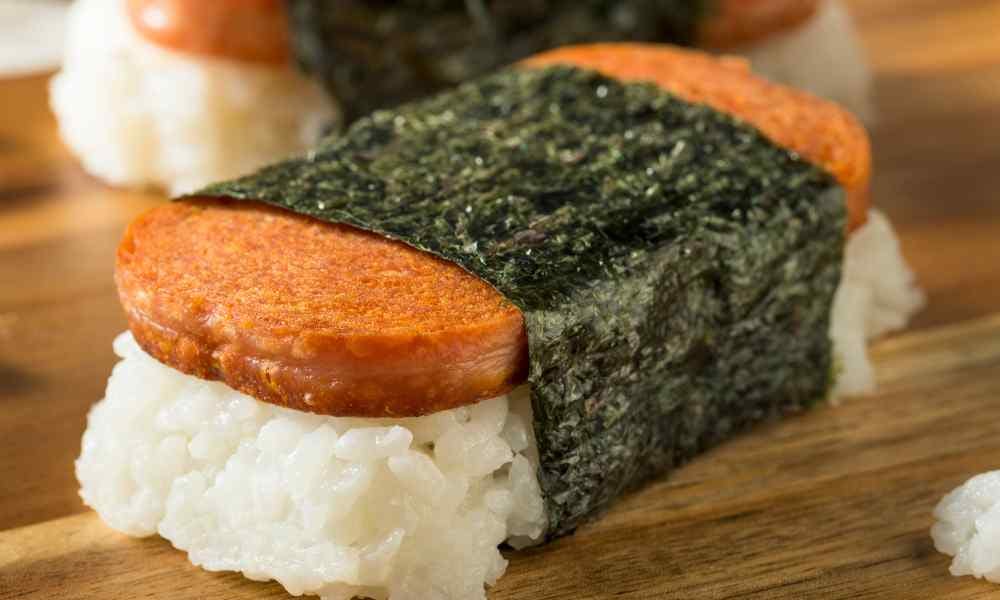SPAM Musubi: convenient, portable, and cheap. Most people love SPAM in Hawaii, and a musubi is the go-to way to enjoy the canned meat.
You’ll see SPAM Musubi everywhere in the islands. It’s kind of like Hawaii’s (tastier) version of a food bar or peanut butter sandwich. It’s common to see people pull one out of a jacket pocket for a quick lunch.
This is a treat with rice and SPAM Hawaii loves to eat, but how did it become so popular? Let’s learn more about Hawaii’s SPAM Musubi.
What is SPAM Musubi
There are a few variations, but the basic musubi is a block of sticky rice topped with a slice of cooked SPAM. Then, a wrap of nori holds it all together (nori is the kind of seaweed that holds sushi together).
Because the rice is sticky and pressed, the whole thing stays together when eaten by hand, like a sandwich. Some recipes call for the SPAM to be layered between two blocks of rice, but it’s more common to see SPAM on top of one block of rice.
In Hawaii, SPAM is a staple (even if not everyone knows what’s inside SPAM). So is rice. So, it makes sense that the two come together for a popular snack.
Some people fry the meat, some grill it, and some add soy or teriyaki sauce during or just after cooking. Often, they’ll sprinkle furikake (chopped seaweed) in the rice, so you may see black flakes. Don’t worry – there is nothing wrong with the rice, it is just for added flavor.
Some places sell a Hawaii SPAM musubi with a layer of egg, or a similar musubi with bright red hot dogs on top instead of SPAM (split in half so they lay flat). Either way, the musubi are wrapped in clear plastic, making them easy to carry.
Where to Find Hawaii SPAM Musubi
During finals at the cafeteria on campus, there is a giant pile of little plastic Musubi packages in the morning. People grab two or three to eat as they walk across campus, stuffing them in pockets.
In my college days, they were a dollar each. Inflation has gotten the better of their prices, but they’re still the cheapest and most filling snack you’ll find.
When you’re ready to try Musubi with SPAM in Hawaii, you’ll have no problem finding one. Look in the grab-and-go section of a grocery store or gas station. Many locals pick up SPAM Musubi at Hawaii 7-11 before work, school, or a beach day.
The SPAM musubi is also an example of eating like a local to save money on your Hawaii vacation. Both peanut butter and bread are more expensive here than on the mainland. You may find it expensive to duplicate your mainland diet while in the islands.
Other Snacks with SPAM Hawaii Loves to Eat
If you’ve recently fallen in love with the SPAM musubi, you may be ready to try other SPAM foods in Hawaii. Here are some ideas for finding Hawaii’s favorite canned meat in an array of dishes:
- Many restaurants (including L&L BBQ) offer Saimin with SPAM. Saimin is Hawaii’s version of Ramen noodles. You can get it as a soup or fried as a dry noodle.
- Did you know McDonald’s offers a “Local Deluxe Platter” at breakfast that includes SPAM, Portuguese sausage, and rice? Give it a try if you’re having breakfast on-the-go.
- Most breakfast spots will offer a SPAM Hawaii breakfast complete with eggs and rice.
- Some local restaurants will include SPAM in their fried rice.
Trying SPAM and Other New Foods in Hawaii
SPAM may not be to your liking, but give it a try during your Hawaii vacation. You may be surprised how delicious it tastes in a Hawaii SPAM musubi. And, once you’ve tried musubi, look for manapua, a bowl of saimin, or a Loco Moco. If you try a few local dishes here and there, you’ll save money while getting a unique taste of Hawaii — and a great story to tell back home.




